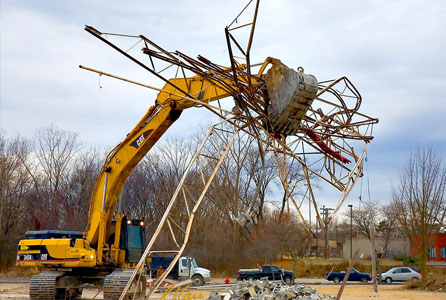
Steel Demolition
Structures the world over that run their course of use and need to be demolished usually have steel frames consisting of I-beams and steel dowel frames within poured concrete. Without the proper equipment and demolition team, getting these buildings leveled could take months or even years. Luckily, demolition teams make use of the most advanced technology to ascertain critical points in structures where specifically measured amounts of explosives will bring the building down upon itself. Though implosion is great at bringing a building down, steel beams are extraordinarily resistant to explosive force and will generally need to be cut using extremely powerful shears so that segmented pieces can be transported and sold as raw material later.
The Right Equipment for the Job
After a building has been toppled, the use of Bobcat backhoes and cranes is typical for the removal and segmenting of large iron material. As industrial equipment has to be outfitted for specific jobs such as steel demolition, there’re attachments available for hydraulic equipment that are giant, high-powered scissors made for cutting the following materials:
- I-beams
- Rebar
- Rivet plates
- Plumbing
These industrial shears can cost tens of thousands of dollars but considering full demolition jobs for skyscrapers and other buildings that are built using iron beams range in profits between hundreds of thousands to millions of dollars, the investment is well worth it. While explosives are ineffective at segmenting steel into manageable pieces, they still are critical to the demolition job and will serve to break steel I-beams at structurally weak points such as intersections of beams that have been welded.
Explosives
While there are various compounds used for the demolition of buildings using explosives, TNT has been and still is the most popular form of explosive used in most demo projects. In the rare case that the demolition being done is underwater, thermite is often used as it doesn’t require oxidation to undergo the chemical process of “explosion”. The reason the word explosion is in quotes is because Thermite does not technically explode. Instead, once it undergoes the chemical process that makes it an effective agent of demolition, it gets super-hot, thus burning through steel found underwater at critical weak points in the structure’s design. Depending on the size and shape of a structure on land, TNT will be placed at welding points on several floors of the building, causing the weight atop the broken I-beams to cause the bottom of the building to buckle, then fall, being crushed by the material falling from above.
Shear-Attachments for Industrial Equipment
Cranes, backhoes and other brands of industrial equipment have shear attachments that can cut with crushing power of tens of thousands of pounds per square inch. Hydraulic systems are usually what powers the shears. Similarly to “the Jaws of Life” which is a piece of equipment used to cut through the steel frames of cars in bad accidents to free people inside, shear-attachments for industrial equipment are simply larger in size as to facilitate cutting through steel I-beams.
